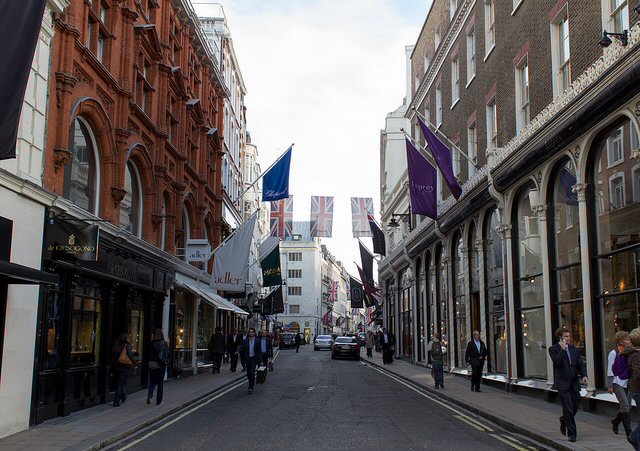Bond Street was first laid out in 1680. At that time, only the section known as Old Bond Street existed. In 1720, the street layout was completed with a further section that is now New Bond Street. Nowadays, Old Bond Street runs between Burlington Gardens and Piccadilly, while New Bond Street is the northern section that connects with Oxford Street.
Bond Street was named after its developer, Sir Thomas Bond. In the late seventeenth century, the area that is now known as Old Bond Street was occupied by a mansion called Clarendon House. This was one of London’s most expensive properties at the time. Following Lord Clarendon’s death, the property was sold and demolished, giving way to what today is known as Old Bond Street.
For over one hundred years, Bond Street has been one of London’s most exclusive shopping destinations, particularly for those looking to buy antiques, art, or jewellery. The internationally renowned Sotheby’s auction house has been based in Bond Street since 1917, and the same can be said about the Fine Art Society, which has been at this London address since it was first inaugurated in 1876.
Information on commercial real estate prices in Bond Street
According to the Cushman & Wakefield Main Streets Across the World report for 2011, Bond Street commercial real estate prices were the sixth highest in the world, only preceded by the Champs Elysées, Tokyo’s Ginza Avenue, Hong Kong’s Causeway Bay, and New York’s Fifth Avenue. At the time of the survey, retail premises were being priced at £577 per square feet. At European level, Bond Street is the continent’s second most expensive street.
A tour of Bond Street
Bond Street can be easily reached by tube from other parts of London. Bond Street underground station is only a few years west of the top of New Bond Street. This station is served by the Central and the Jubilee lines. These underground lines provide links with the DLR and with National Rail services. The northern end of Bond Street can also be reached by bus, as there are as many as 19 bus lines that drop passengers at the corner of Bond Street and Oxford Street. Night buses also ply this route.
Once visitors turn into Bond Street, they will surely notice the large number of high end shops and boutiques. Brands like Bally, Louis Vutton, Burberry, Chopard, Cartier, Chanel, Yves St Laurent, Boudi, Jimmy Choo, Leonidas, Calvin Klein, Emporio Armani, Mulberry, and Missoni are all represented in New Bond Street. At the intersection with Brook Street, visitors will find Fenwick, a five-storey exclusive department store. There are auction shops and a couple of art galleries on the opposite side of the road. Next, and starting in Grafton Street, there is a cluster of luxury jewellery shops. The Fine Art Society can be found near the corner with Burton Street. Sotheby’s is further south, just past Maddox Street.
As visitors turn into Old Bond Street, they will find high end shops selling luxury watches, jewellery, and accessories. Luxury mobile phone retailer Vertu is also in this section of Bond Street. There are a few restaurants where Old Bond Street turns into Piccadilly. The variety and quality of shopping options in Bond Street make it an ideal place to buy quality gifts during a business trip to London.

